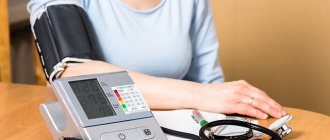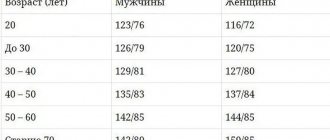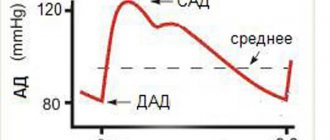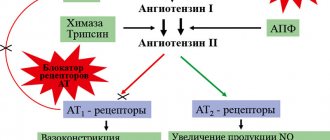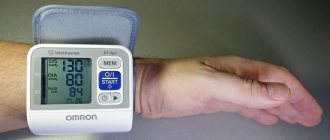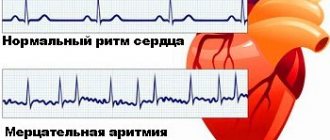- Why does the tonometer show arrhythmia?
- What types of blood pressure monitors show arrhythmia?
- Algorithm and technologies for detecting arrhythmia
- Arrhythmia indicator and associated symptoms
- What to do if the tonometer shows arrhythmia?
- Tonometer for atrial fibrillation
- Selecting a device with a built-in arrhythmia indicator
- Reviews of popular models
To avoid missing the onset of heart disease, you need to monitor your heart rate. Tonometers will help with this; they not only measure blood pressure, but also detect an increased heart rate. What kind of tonometers show arrhythmia, and how to properly respond to the results of such measurements, we will look into further.
Why does the tonometer show arrhythmia?
Arrhythmia is a pathology of the heart rhythm that can occur due to exposure to external factors or various diseases. The reasons why the tonometer begins to show arrhythmia may be the following:
- psychological overstrain, constant stress;
- thyroid dysfunction;
- diabetes;
- heart pathologies or previous heart disease;
- excessive drinking and smoking;
- high blood pressure;
- poor nutrition and metabolic disorders;
- hormonal disbalance;
- addiction to caffeinated drinks;
- infectious processes and fungal infections;
- menopause;
- brain diseases.
Which tonometer is better
How to choose a device for measuring pressure: secrets from a pharmacist
Sooner or later, everyone needs to measure their blood pressure. And if this need becomes systematic, you should think about buying a tonometer. In pharmacies, medical equipment stores and even supermarkets you will find a huge range of devices. How to understand the measurement chaos and make the right choice?
When is it time to look for a blood pressure monitor?
The belief that only very old people measure blood pressure is not true. In fact, a tonometer may also be needed at a young age, including completely healthy people. Thus, monitoring blood pressure levels is necessary for pregnant women. According to statistics, 5–20% of women in an interesting situation develop hypertension. For them, a blood pressure monitor automatically becomes one of their essential items.
Blood pressure is also measured by athletes who exhaust their bodies with serious physical activity. Monitoring pulse and blood pressure in such cases is a necessary measure to prevent cardiovascular surprises.
And, of course, hypertensive patients. If you notice that your blood pressure may rise above 130/90, do not put off purchasing a blood pressure monitor. But first you need to understand which device to give preference to.
What is better - mechanics or automatic?
And the first question that buyers face is: what, besides price, is the difference between a mechanical and automatic blood pressure monitor?
Mechanical vehicles are among the most difficult to manage. To measure pressure with their help, you will need a keen eye that can detect the fluctuations of the pressure gauge needle, and a sensitive ear that will hear even a quiet sound at the right moment.
However, a mechanical tonometer also has undoubted advantages. It is considered the most accurate after mercury, which has already gone into oblivion. The mechanics allow you to record indicators with virtually no error, it can serve for many years, and its price is not at all annoying.
Automatic devices, of course, are more expensive, but they are much faster and simpler than their old counterpart, just as a motorcycle is more agile and convenient than a reliable but slow bicycle. And not everyone enjoys pedaling every day. At the same time, the accuracy of some automatic tonometers is almost as good as mechanical ones.
Also, unlike mechanics, all automatic machines measure your pulse. And the additional functions that especially “advanced” models are equipped with can even prevent a cardiovascular accident. But choosing a machine turns out to be not so easy.
The diverse world of electronics
Semi-automatic devices occupy an intermediate place between mechanical and automatic devices. The semi-automatic machine “hears” and “sees” itself, but does not know how to pump air into the cuff. Air pumping occurs in the same way as in mechanical models. The device will notify you with a gentle beep when you can stop vigorously squeezing the bulb and relax while awaiting the results.
In terms of accuracy, semi-automatic machines are practically not inferior to mechanics, and the difference in price between them is not so sensitive. Therefore, a semi-automatic machine is often the best choice for those who want to get maximum convenience with minimal material losses.
There are two types of slot machines: wrist-mounted and shoulder-mounted. Wrist blood pressure monitors look very ergonomic, but their accuracy leaves much to be desired. The vessels of the wrist have a small gap, and no electronics can accurately calculate the pressure from them.
Wrist tonometers are more often used by athletes who are not afraid of a small error in the readings. For hypertensive patients, it is better to pay attention to the shoulder machine. This is where accuracy and convenience are, “two in one”!
The cuff of the brachial tonometer is located on the upper arm, along the inner side of which large vessels pass. This is why shoulder blood pressure monitors are very punctual. And, of course, an automatic machine is a convenience. The patient’s mission during blood pressure measurement is limited to securing and, after the procedure, removing the cuff. Oh, yes, you need to remember to press the one and only button, which will start the process.
What can an automatic blood pressure monitor do?
It would be too trivial if the capabilities of automatic tonometers were limited to measuring blood pressure and pulse. Electronics can do more! And before choosing a device, it is better to familiarize yourself with the additional functions and come to a conclusion whether it is worth paying for innovative developments.
The most common function that automatic and semi-automatic devices are equipped with is the diagnosis of arrhythmia. The tonometer monitors irregular heartbeats and, having identified them, signals danger. The device recognizes arrhythmia at the earliest stages, when you do not yet feel clinical manifestations. Therefore, determining arrhythmia is one of the most important functions for patients at risk: patients with hypertension and other diseases of the heart and blood vessels.
There are also tonometers that can detect atrial fibrillation, a common and very dangerous rhythm disorder. The most modern and, as a rule, expensive automatic devices are equipped with this function.
Another useful technology involves analyzing three consecutive measurements and producing an average result.
It is no secret that the accuracy of an automatic tonometer largely depends on proper preparation for measuring blood pressure. To get the correct results, you should rest for 5-10 minutes before the procedure. You must be calm. During the procedure you cannot move, talk, or much more. By the way, these requirements apply to all types of tonometers - both automatic and mechanical.
However, if you did not have time to rest before the measurement, mechanics will still be more accurate than automation. The exception is devices that are equipped with a function for averaging three measurements. In one measurement, the tonometer manages to determine the indicators three times, process them and produce a “weighted average” and the most accurate result.
Don't rush to pay
So, you have decided on the type of device. What's next? Next, be sure to take a test measurement. Hold the tonometer in your hands and make sure that its parameters suit you. Check whether the standard cuff is long enough for you - for example, obese people have to be especially scrupulous in choosing it. If you have poor eyesight, pay attention to the size of the screen: the larger it is, the larger the indicators displayed on it.
Don't forget about the network adapter - it connects to all machines except wrist ones. For those who regularly measure blood pressure, the adapter is indispensable. Sometimes it is sold complete with a tonometer, but most often it is purchased separately.
When you have touched, held and tried on everything and you are pleasantly pleased with the result of these actions, check another important point - the issuance of a warranty card. This document will protect you from manufacturing defects and will be a worthy conclusion to the difficult purchasing process.
What types of blood pressure monitors show arrhythmia?
There are three types of tonometers - mechanical, semi-automatic and automatic. The mechanical method is considered the most accurate in measuring pressure, but without certain knowledge and a phonendoscope it does not allow you to independently detect a heart rhythm disorder. Devices with an automatic or semi-automatic pulse measurement function immediately allow you to measure several indicators of a person’s vital activity:
- pressure;
- heart rate per minute;
- arrhythmia.
The new generation devices differ from each other only in their configuration. If you don’t need to do anything when using an automatic tonometer - all measurements are carried out by recording fluctuations in blood flow with special sensors attached to bare skin, then when using semi-automatic devices you need to pump air into the cuff yourself using a bulb.
Thanks to the integrated arrhythmia detection function, modern blood pressure monitors show more accurate values, even when it comes to people with a rapid heart rate. They accurately detect irregularities in the heartbeat, so such fluctuations do not distort the final result.
Such devices often operate using the oscillometric method, which minimizes the influence of the human factor on measurement accuracy. Its essence is to monitor pressure fluctuations in the tonometer cuff, which occurs when blood passes through a compressed section of the artery. In new models of devices, the electronic sensor is built directly into the cuff. It evaluates pressure fluctuations in it, and then converts the received readings into digital values and displays it on the screen.
How the tonometer detects and displays the problem
Functions for determining pulse rate are available in automatic and semi-automatic tonometers. The operating principle of the device is based on unstable pressure in the cuff, which occurs as a result of blood flow in the pinched artery. These vibrations are converted into electrical signals by the action of an electronic device. An automatic program analyzes the readings and turns them into numerical values.
From what functions the tonometer is equipped with, you can find out blood pressure, the frequency of contraction of the heart muscle and the presence of arrhythmia. Modern devices store previous indicators necessary for comparison.
A mechanical device does not make it possible to detect abnormalities in the functioning of the heart.
How the process of measuring pressure occurs:
- A cuff is placed on the forearm and air is supplied to it automatically or by a pump.
- It increases in size, causing compression of the vessel, and blood stops circulating.
- If you use a phonendoscope, then at the moment there is silence because the blood is not circulating.
- Gradually, air is released through a special valve, and the blood begins to circulate, as indicated by knocking sounds in the phonendoscope. This will be the upper pressure reading that will appear on the monitor.
- The blood flow gradually improves and is restored, at this moment the knocking stops - this will be an indicator of lower blood pressure. Automatic blood pressure monitors do not require human intervention.
Correct use of the automatic blood pressure monitor
The arrhythmia diagnostic function is not available on all tonometer models. It is determined as follows: the tonometer measures pressure and pulse several times, at short intervals, until there are at least a couple of results without determining arrhythmia. The data is then processed and an average is displayed on the screen.
Moreover, modern models of tonometers can independently distinguish the symptoms of arrhythmia from false ones that resulted from the influence of external factors.
Algorithm and technologies for detecting arrhythmia
The principle of determining arrhythmia with a tonometer is as follows:
- Several measurements are performed in a row with short pauses.
- When at least 2 results are obtained without symptoms of arrhythmia, the measurement process stops.
- The display shows the average heart rate.
- The corresponding icon lights up, indicating problems with the heart rhythm.
The results of such measurements are the most accurate, since the device distinguishes symptoms of cardiovascular pathology from false ones caused by external factors - increased emotionality, heavy physical exertion, etc.
To implement such an algorithm, the latest technologies are used, among which the following are already patented:
- Microlife Average Mode (MAM) from a Swiss company This is an intelligent technology that calculates an average by taking 3 consecutive blood pressure measurements at 15-second intervals. The algorithm excludes the influence of external factors - anxiety, arrhythmia, fatigue, small hand movements. The BP A100 Plus model is equipped with similar technology.
- Pulse Arrhythmia Detection (PAD) also from Detects irregular heartbeat, excluding external factors. Helps identify arrhythmia in the early stages.
- 3Check from the British company B.Well. As in the previous case, the device takes 3 measurements at 15-second intervals. After the necessary calculations, the average value appears on the display. The technology is presented in the B.Well WA-55 model.
Which tonometer is better
How to choose a device for measuring pressure: secrets from a pharmacist
Sooner or later, everyone needs to measure their blood pressure. And if this need becomes systematic, you should think about buying a tonometer. In pharmacies, medical equipment stores and even supermarkets you will find a huge range of devices. How to understand the measurement chaos and make the right choice?
When is it time to look for a blood pressure monitor?
The belief that only very old people measure blood pressure is not true. In fact, a tonometer may also be needed at a young age, including completely healthy people. Thus, monitoring blood pressure levels is necessary for pregnant women. According to statistics, 5–20% of women in an interesting situation develop hypertension. For them, a blood pressure monitor automatically becomes one of their essential items.
Blood pressure is also measured by athletes who exhaust their bodies with serious physical activity. Monitoring pulse and blood pressure in such cases is a necessary measure to prevent cardiovascular surprises.
And, of course, hypertensive patients. If you notice that your blood pressure may rise above 130/90, do not put off purchasing a blood pressure monitor. But first you need to understand which device to give preference to.
What is better - mechanics or automatic?
And the first question that buyers face is: what, besides price, is the difference between a mechanical and automatic blood pressure monitor?
Mechanical vehicles are among the most difficult to manage. To measure pressure with their help, you will need a keen eye that can detect the fluctuations of the pressure gauge needle, and a sensitive ear that will hear even a quiet sound at the right moment.
However, a mechanical tonometer also has undoubted advantages. It is considered the most accurate after mercury, which has already gone into oblivion. The mechanics allow you to record indicators with virtually no error, it can serve for many years, and its price is not at all annoying.
Automatic devices, of course, are more expensive, but they are much faster and simpler than their old counterpart, just as a motorcycle is more agile and convenient than a reliable but slow bicycle. And not everyone enjoys pedaling every day. At the same time, the accuracy of some automatic tonometers is almost as good as mechanical ones.
Also, unlike mechanics, all automatic machines measure your pulse. And the additional functions that especially “advanced” models are equipped with can even prevent a cardiovascular accident. But choosing a machine turns out to be not so easy.
The diverse world of electronics
Semi-automatic devices occupy an intermediate place between mechanical and automatic devices. The semi-automatic machine “hears” and “sees” itself, but does not know how to pump air into the cuff. Air pumping occurs in the same way as in mechanical models. The device will notify you with a gentle beep when you can stop vigorously squeezing the bulb and relax while awaiting the results.
In terms of accuracy, semi-automatic machines are practically not inferior to mechanics, and the difference in price between them is not so sensitive. Therefore, a semi-automatic machine is often the best choice for those who want to get maximum convenience with minimal material losses.
There are two types of slot machines: wrist-mounted and shoulder-mounted. Wrist blood pressure monitors look very ergonomic, but their accuracy leaves much to be desired. The vessels of the wrist have a small gap, and no electronics can accurately calculate the pressure from them.
Wrist tonometers are more often used by athletes who are not afraid of a small error in the readings. For hypertensive patients, it is better to pay attention to the shoulder machine. This is where accuracy and convenience are, “two in one”!
The cuff of the brachial tonometer is located on the upper arm, along the inner side of which large vessels pass. This is why shoulder blood pressure monitors are very punctual. And, of course, an automatic machine is a convenience. The patient’s mission during blood pressure measurement is limited to securing and, after the procedure, removing the cuff. Oh, yes, you need to remember to press the one and only button, which will start the process.
What can an automatic blood pressure monitor do?
It would be too trivial if the capabilities of automatic tonometers were limited to measuring blood pressure and pulse. Electronics can do more! And before choosing a device, it is better to familiarize yourself with the additional functions and come to a conclusion whether it is worth paying for innovative developments.
The most common function that automatic and semi-automatic devices are equipped with is the diagnosis of arrhythmia. The tonometer monitors irregular heartbeats and, having identified them, signals danger. The device recognizes arrhythmia at the earliest stages, when you do not yet feel clinical manifestations. Therefore, determining arrhythmia is one of the most important functions for patients at risk: patients with hypertension and other diseases of the heart and blood vessels.
There are also tonometers that can detect atrial fibrillation, a common and very dangerous rhythm disorder. The most modern and, as a rule, expensive automatic devices are equipped with this function.
Another useful technology involves analyzing three consecutive measurements and producing an average result.
It is no secret that the accuracy of an automatic tonometer largely depends on proper preparation for measuring blood pressure. To get the correct results, you should rest for 5-10 minutes before the procedure. You must be calm. During the procedure you cannot move, talk, or much more. By the way, these requirements apply to all types of tonometers - both automatic and mechanical.
However, if you did not have time to rest before the measurement, mechanics will still be more accurate than automation. The exception is devices that are equipped with a function for averaging three measurements. In one measurement, the tonometer manages to determine the indicators three times, process them and produce a “weighted average” and the most accurate result.
Don't rush to pay
So, you have decided on the type of device. What's next? Next, be sure to take a test measurement. Hold the tonometer in your hands and make sure that its parameters suit you. Check whether the standard cuff is long enough for you - for example, obese people have to be especially scrupulous in choosing it. If you have poor eyesight, pay attention to the size of the screen: the larger it is, the larger the indicators displayed on it.
Don't forget about the network adapter - it connects to all machines except wrist ones. For those who regularly measure blood pressure, the adapter is indispensable. Sometimes it is sold complete with a tonometer, but most often it is purchased separately.
When you have touched, held and tried on everything and you are pleasantly pleased with the result of these actions, check another important point - the issuance of a warranty card. This document will protect you from manufacturing defects and will be a worthy conclusion to the difficult purchasing process.
Arrhythmia indicator and associated symptoms
Depending on the tonometer models, the arrhythmia indicator may differ in appearance, but in most cases it is shown on the device display in the form of a heart.
If heartbeat disturbances are detected, this icon will blink, and in some models it will also be accompanied by a signal. The person himself may note the following manifestations of arrhythmia:
- feeling of irregular heartbeat;
- dizziness and fainting;
- lack of air;
- fading, tremors and interruptions in heart function;
- discomfort in the heart area;
- feeling of frequent heartbeat;
- black spots before the eyes;
- chronic fatigue;
- profuse sweating;
- headache;
- irritability;
- drowsiness.
The presence of at least 3 signs from this list may indicate arrhythmia. In this case, the tonometer will show more than 100 beats per minute.
Intracardiac electrophysiological study
EPI is used in cases of serious cardiac pathologies, when the patient experiences significant interruptions in the functioning of the heart. Before referring a patient for this test, the person must undergo a complete diagnosis, including ECG, echocardiography, stress tests and blood tests. The procedure is carried out without anesthesia or sedatives.
- The brachial, femoral or subclavian artery is punctured.
- Electrodes are inserted into the chambers of the heart and electrocardiogram recording begins.
- The atria and ventricles must be stimulated to determine the functional characteristics of the myocardium.
- They begin to examine the area damaged by the arrhythmia.
At the end of the EFI, doctors select antiarrhythmic drugs. Complications after this procedure are much less common than after stress tests and tilt tests under the influence of medications. Sometimes patients physically feel pain in the heart, but it goes away after the examination is completed.
If the patient suffers from severe rhythm disturbances, but during the examination the doctor can stop their source. It also does not use any medications that put the patient to sleep. Despite the complexity of the procedures, EPI is considered the safest and most accurate method for diagnosing heart rhythm disorders, as well as their further elimination.
What to do if the tonometer shows arrhythmia?
Regardless of which tonometer is used, 3-4 measurements should be taken at intervals of 10 minutes to confirm the diagnosis. If every time the tonometer shows arrhythmia, and the person experiences a “fading” of the heart or, conversely, chaotic beatings, it is necessary to urgently consult a cardiologist. Using instrumental diagnostic methods, he will find out exactly why the device shows arrhythmia and draw up a treatment plan.
To clarify the diagnosis, the therapist often conducts the following examinations:
- examination with anamnesis to find out about the presence of bad habits and the patient’s lifestyle;
- general blood and urine analysis;
- ECG;
- blood test for cholesterol and sugar levels;
- consultation with an ophthalmologist or neurologist.
Based on the research results, the therapist may refer you to a cardiologist and/or endocrinologist. They often prescribe additional tests:
- Ultrasound of the heart;
- daily monitoring;
- MRI.
If the disease is at an early stage, then they try to cure it by adjusting the lifestyle (quitting smoking, salty and spicy foods, alcohol, caffeine-containing drinks). In case of an advanced stage, medications are prescribed:
- With atrial fibrillation, low blood pressure is noted, so medications are prescribed that stabilize blood pressure readings:
- ginseng tincture;
- Aralia tincture;
- Caffeamine;
- Ethmozin;
- Korglykon.
- To restore the rhythm in atrial fibrillation, the following is prescribed:
- beta blockers;
- calcium ion blockers;
- cardiac glycosides;
- Amiodarone.
- To lower blood pressure in other types of arrhythmia, use:
- diuretics;
- ACE inhibitors;
- calcium antagonists;
- beta blockers.
In any case, it is necessary to strictly adhere to all the doctor’s instructions, since therapy is selected individually for each person. Self-medication in this case is unacceptable.
If the arrhythmia icon appears rarely, then there is no cause for concern. The person may not have properly secured the cuff, or the measurement results may have been influenced by external factors.
Which blood pressure monitor should you choose?
There is a large selection of meters designed for different purposes and focused on diagnosing blood pressure, pulse and its failures. Depending on the mechanism of action, tonometers are divided into mechanical, semi-automatic and automatic. The mechanics provide accurate results in determining blood pressure, but do not show changes in heart rate, although this is a fairly common problem. An electronic tonometer with a function for detecting atrial fibrillation will help to detect the presence of irregularities in the heart rhythm when measuring pressure. Therefore, patients who need to monitor blood pressure and changes in the cardiovascular system are recommended to purchase devices that have a built-in tonometer and heart rate monitor. An icon with an indicator of arrhythmia, including atrial fibrillation, also appears on the screen of the medical device.
Use for heart rhythm disorders
Modern devices that have an arrhythmia indicator rarely make mistakes, since they perform calculations and display results based on the analysis of measurements. The device takes into account the last 3 measurements, which are automatically recorded in memory, or the heart rate rhythm is read three times within one session. In any case, the patient receives the most accurate heart rate indicator. The multifunctional tonometer with indication has special icons on the screen that notify you of pulse failures. The most commonly used symbol is a heart that blinks. If pulse irregularities occur frequently, it is better to consult a doctor, since the cause may be cardiac arrhythmia detected at an early stage.
For atrial pathology
Devices focused on identifying the disease do not identify other types of failures, since they are configured specifically for heart rate flickering. In case of atrial fibrillation, the automatic tonometer shows deviations of the pulse from the norm and disruptions in its frequency, thanks to a special algorithm for analyzing the results. Devices from Microlife, which are based on AFIB technology, and tonometers from the German company PAUL HARTMANN with the Duo Sensor function are the best for diagnosing irregular arrhythmia.
Tonometer for atrial fibrillation
According to statistics, the cause of 20% of strokes is atrial fibrillation in an advanced stage, so it is important to diagnose it in time. Tonometers that are equipped with one of the following algorithms for detecting atrial fibrillation will help with this:
- AFIB from Microlife. The BP A110 and A110 Afib devices are equipped with this technology. The accuracy of their measurements is comparable to the accuracy of electrocardiography and reaches 100%. The disadvantage of these devices is that they react only to this type of arrhythmia, that is, they do not work with other types of this disease. If during measurement in MAM mode the device detects atrial fibrillation, a corresponding icon will appear on the screen.
- Duo Sensor from company Paul Hartmann. To identify the disease, he uses the following methods: oscillometric and the Korotkoff sound method (auscultatory or sound), characteristic of mechanical devices. The latter algorithm is the most accurate, but for low pulse tones it automatically switches to the oscillometric method. Thanks to this, maximum measurement accuracy is achieved.
The atrial fibrillation indicator is also presented as a heart sign. If such a pathology is present, it appears on the screen, which may be accompanied by a sound or voice signal. To confirm the diagnosis, it is also worth establishing the presence of other signs of the disease in the form of arrhythmia, discrepancy between heart rate and pulse, and different filling of the “pulse wave.”
Arrhythmia indicator on a tonometer: should you trust it?
To date, many devices have been developed for measuring blood pressure. The photo shows different types of modern tonometers. Let's take a closer look at them.
A mechanical tonometer consists of a bulb, a dial and a cuff, connected by rubber tubes.
The advantage of this type of device is its low cost, absence of errors against the background of arrhythmia, movements, and conversation. The disadvantages are that measuring pressure mechanically requires skills and a stethoscope. There is no arrhythmia indicator on the tonometer. An unreliable result may be obtained due to the patient’s decreased hearing, weakened tones, or tachycardia.
Mercury tonometer. The difference between this device is the mercury manometer. Used in some medical institutions, it is considered the most accurate. A clear disadvantage of this type of equipment will be the toxicity of mercury.
Automatic blood pressure monitor. Consists of a cuff and a recorder with a digital screen.
Such modern devices measure blood pressure, pulse, and can also be equipped with an indicator of arrhythmia, movements, and an indicator of the correct position of the hand. Some electronic models have a built-in printer.
The presence of built-in memory allows you to save data for a long time. The disadvantage of the device is the need for charging and the error in the measurement results.
The device can be mounted on the shoulder (shown above), as well as on the wrist and finger.
Wrist tonometer. Compactness and automaticity make this device quite convenient, but it is suitable for people under 50 years old.
Finger device. In addition to blood pressure, the tonometer allows you to measure blood saturation (oxygen saturation) and pulse. The device reacts instantly after putting it on your finger.
Semi-automatic tonometer. It is an intermediate option between the two above. It has a bulb, a cuff and a digital screen with buttons. The undoubted advantage of this device is that the device has different functions and does not require charging or batteries, but the disadvantage is the need to use physical force when pumping air.
Most models have the same operating principle and are based on the Korotkov method, that is, pulse wave recognition.
The rules for working with a mechanical tonometer are as follows: first, place a cuff on the shoulder, then pump up air using a bulb and, slowly releasing it, listen to the first and last heart sounds using a stethoscope.
A semi-automatic tonometer is easier to use: having secured the cuff, just press the “start” button and after the signal, pump up the air with the bulb, and then deflate the remaining air in the cuff. The result will be displayed on the recorder screen.
The machine is the easiest to use. The person only needs to put the cuff in the correct place and press the button, after which the result will be displayed on the screen.
Arrhythmia is an irregular contraction of the heart. There are quite a few reasons for this condition. These can be both organic (pathology of the heart and its structures) and functional disorders (hormonal imbalance, respiratory arrhythmia, excessive potassium in the blood). Drinking alcohol can trigger arrhythmia in people with bundle branch block.
Usually, a disturbance in the heart rhythm is felt as interruptions, freezing, somersaults in the heart. The episode may be accompanied by a feeling of shortness of breath.
An arrhythmia indicator on a tonometer is a modern technology that allows you to assess the rhythm of a person’s heartbeat while measuring blood pressure.
The value of such an indicator is that, having recorded the pathology, a person can promptly seek help and begin treatment.
How it works?
The principle of operation of the mechanism is as follows: a person measures pressure in the usual way, and the device analyzes pulse waves or oscillations (depending on the device).
If cardiac activity is rhythmic, the measurement result is immediately displayed on the screen. In case of irregular heartbeat (extrasystole, blockade, atrial fibrillation and other pathologies), a special symbol appears.
If the indicator is triggered, it is worth repeating the measurement.
Against the background of arrhythmia, the measurement can be reliable or unreliable. A reliable indicator is displayed on the monitor along with an arrhythmia indicator, and if the data received is unreliable, the result is not displayed.
The symbol “E” (Error) appears on the display if the electronic tonometer cannot distinguish the pulse wave and estimate the pressure (when the heart contracts ineffectively, which occurs with atrial flutter and fibrillation). However, many modern blood pressure monitors have built-in software that can detect atrial fibrillation. For example, AFIB technology from Microlife, Duo Sensor from Paul Hartmann and others.
The diagnostic value of the arrhythmia indicator is high, especially in elderly people suffering from coronary heart disease.
conclusions
Arrhythmia on a blood pressure monitor is not always a reason to panic. Sometimes it is enough to rest a little, relax, take the correct position and take the measurement again. If the disorder does not disappear or the atrial fibrillation icon is displayed, then the patient should consult a cardiologist.
A compact, high-precision and multifunctional device that allows you to measure pressure, pulse, and assess the correctness of the heart rhythm - this is undoubtedly the best tonometer for arrhythmia.
Selecting a device with a built-in arrhythmia indicator
When purchasing tonometers with a built-in arrhythmia indicator, special attention should be paid to the following factors:
- Cuff size . The standard is 22-32 cm. You need to select it according to your arm, because if the cuff is small, it will compress the vessels and distort the measurement indicators. For children, you need to buy a special small cuff made of nylon using seamless technology.
- Display size . The bigger it is, the better. All indicators fit on the large screen, so you can easily notice the flickering heart indicating an arrhythmia. Attention should also be paid to the font size. It should be comfortable for people even with low vision.
- Nutrition . All automatic and semi-automatic machines operate on electricity. The best option is a model that can operate both from mains and batteries.
In addition to the listed basic parameters, it is also worth taking into account the presence of additional functions that simplify the use of the tonometer. These include:
- display backlight;
- accompaniment of the output of measurement results with an audio or voice signal;
- built-in memory that stores the results of the latest measurements;
- calculation of average blood pressure and pulse values.
The newest models of tonometers have connectors for connecting to a computer or printer, so all data can be printed and shown to the doctor.
The process of measuring pressure and its features on different types of devices
For people suffering from heart disease, it is important to find out which blood pressure monitor is best for arrhythmia, since it is a common accompanying symptom. Measurements will have to be taken regularly, so it makes sense to buy a more functional device. It is especially important to purchase a good device for monitoring heartbeat and blood pressure for older people. They often have problems with vision, memory and hearing. A device with built-in memory, simple controls and a large screen can solve them.
People who like to travel should look for a normal wrist blood pressure monitor. Due to its small size, you can take it with you everywhere. You will not have to take off your clothes during the measurement, so you can carry out the procedure anywhere. The disadvantage of the device is its contraindications. The tonometer will not be able to provide accurate results in the presence of advanced atherosclerosis or due to age-related changes in blood vessels, since the pulse on the wrist will be too weak for it to record it.
When choosing a measuring device, it is important to pay attention to the following nuances:
- The cuff should be selected according to your arm. The standard is 22-32 cm. For large people, it is advisable to look for a large size, since due to strong compression, the result may be distorted. For children you will have to buy a special small cuff. It is made from nylon using seamless technology.
- The display needs to be selected as much as possible. The one-line, outdated version only displays blood pressure and pulse. A larger screen size will make it possible to see all the indicators at once, including the arrhythmia indicator, average indicators, color scale, battery charge and much more. It is equally important that the font is large enough for people with low vision. You can see how the data will look on the screen by asking a pharmacist to demonstrate the operation of the device or by watching a video about it on the Internet.
The display and cuff are the basis of the tonometer, so you need to choose them carefully. If there are no significant differences between the models, then you should pay attention to their additional functions:
- The arrhythmia indicator will be highlighted on the display. Sometimes its detection is accompanied by a sound signal. New models of measuring instruments automatically carry out all the necessary calculations to obtain accurate results. In more outdated versions there is no built-in algorithm of actions, so it is advisable to take several measurements.
- Built-in memory is common to virtually all semi-automatic and automatic devices. The number of entries varies from 1 to 90. They contain information about blood pressure and pulse. Information about arrhythmia is available if there is a corresponding indicator.
- The function of calculating average pressure and pulse indicators is characteristic of virtually all measuring devices.
- A sound notification is characteristic of the end of the measurement process. Not all tonometers have this function.
- Quick determination of pressure and pulse is built into some devices. There are no special errors.
- Family blood pressure monitors can be customized for each person. The data will be written to a separate location.
- The most in demand are universal models of measuring devices that are powered either from batteries or from the mains using an adapter. The advantage is especially relevant for home use, as costs are reduced.
- Many modern versions of tonometers can be connected to a printer and computer to print out accumulated measurements. This feature is useful if you need to show the results to the doctor and do not want to carry the device to him.
Electronic models of measuring devices are great for home use. Especially with arrhythmia, problems with vision and hearing, and lack of necessary skills in using mechanical types of tonometers. The patient just needs to press 1 button and the device will do everything on its own (pump air, determine blood pressure and pulse levels, and record data).
: first place a cuff on the shoulder, then pump up the air using a bulb and, slowly releasing it, listen to the first and last heart sounds using a stethoscope.
The machine is the easiest to use. The person only needs to put the cuff in the correct place and press the button, after which the result will be displayed on the screen.
Blood pressure (BP), like body temperature, is a value that varies depending on the influence of various factors. That is why its measurement is mandatory at a doctor’s appointment or upon admission to a hospital. The data obtained allows the doctor to diagnose, for example, hypertension.
However, it is important to know that in order to obtain broader information about the patient’s health status, the pressure on both arms should be measured and the readings compared. The measurement result is indicated in the form of two values: systolic (upper) and diastolic (lower). Systolic pressure is listed first and refers to the level of blood pressure during heart contraction. The second digit informs about the level of blood pressure when the heart relaxes.
A few decades ago, scientists noticed that the pressure on the right and left hands may differ from each other. Later, doctors also established a relationship between the difference in pressure readings on different hands and vascular diseases. Some doctors are even of the opinion that every mm of difference in measurements significantly, namely by 9%, increases the risk of death in the next decade. However, in order not to panic, you should understand what could affect the difference in these readings.
Our readers successfully use ReCardio to treat hypertension. Seeing how popular this product is, we decided to bring it to your attention. there...
- Experiences. When starting to measure blood pressure, a person may become nervous, and this anxiety is reflected in the readings of both blood pressure and pulse. Having calmed down and measured the pressure on the second arm, he gets a significantly different result. Therefore, it is very important to start measuring in a relaxed state. It is advisable not to measure it yourself, but to entrust it to another person.
- Anatomical features. In most people, especially those whose activities involve stress, fibrosis forms in the muscles of the shoulder girdle, which leads to pinching of the neurovascular bundle. For this reason, blood pressure in the right arm may be higher than in the left. Anatomical features also include stronger muscles of one of the arms.
- Overwork, poor sleep, nervousness.
- Circulatory disorders. Such changes in the body can be associated with a number of diseases, which can only be diagnosed with a more thorough examination.
Different pressure in the hands is not a diagnosis, but only a reason to see a doctor. The diseases that this fact may indicate are in most cases associated with narrowing of the arteries and loss of their elasticity. In this case we are talking about the subclavian artery, which is part of the systemic circulation.
It supplies blood to the neck and arms. If stenosis (narrowing) of the subclavian artery occurs, then the tissues that should be supplied with blood and oxygen from it do not receive enough of it. This, in turn, leads to the formation of atherosclerotic plaques at the narrowing sites, which can, in general, block the flow of blood in the arteries. And this is already a threat of ischemic stroke.
Another disease in which different pressures can be observed in symmetrical limbs is nonspecific aortoarteritis or, as it is called, Takayasu syndrome. The disease most often affects young women, although it also occurs in men. It causes inflammation of the walls of blood vessels, which leads to their clogging.
Due to impaired blood flow, pathological changes occur in organs that are not supplied with blood and oxygen in the required quantities. With timely detection and treatment of this disease, the risk of mortality can be reduced to 10% or lower. If the disease remains undiagnosed, the probability of death increases to 75%.
If the pressure difference does not exceed 10 mm, there is no cause for concern. This difference is considered a physiological norm. However, if you find that the difference is more than 10-15 mm, then this should cause concern, so do not put off visiting a doctor. For young people, this is a reason to suspect vascular defects, for older people - the likelihood of coronary heart disease, hypertension, cerebrovascular accident, which increases the risk of stroke and heart attack. If the difference in pressure is more than 20 mm, then this may indicate atherosclerotic narrowing, or occlusion, of the subclavian artery.
Different pressures on different hands may not manifest themselves in any way, but may be accompanied by the following symptoms:
- weakness;
- ringing in the ears;
- dizziness;
- rapid fatigue;
- chilly fingers;
- discomfort and others.
The presence of at least one of them in combination with various pressure readings on the hands is also a reason to consult a doctor and undergo a diagnosis. The earlier the disease can be identified, the greater the chances of getting rid of it or minimizing the negative impact. Most diseases at an early stage can be asymptomatic.
If you decide to monitor your blood pressure at home, you should follow certain rules to get accurate results:
- Blood pressure should be measured at the same time, preferably 2 times a day.
- A mechanical tonometer can give the most accurate readings.
- Before taking measurements, you should relax and rest for at least 5 minutes.
- Take the measurement while sitting, leaning on the back of a chair and without crossing your legs. The hand should lie completely on the table, not hang down, and be at heart level.
- It is best if someone else measures the pressure, since when you carry out the procedure yourself, you have to make an effort to squeeze the bulb, which can affect the results, especially if you then measure the pressure on your other hand.
- An interval of 4-5 minutes should be maintained between measuring the pressure on one and the other arm.
- It is best to avoid coffee, vasoconstrictor drugs, smoking and exercise at least an hour before measuring blood pressure.
Reviews of popular models
Let’s take a closer look at the most popular models equipped with this function.
Tensoval Duo Control
A tonometer from the German manufacturer Hartmann with two measurement methods - oscillometric and auscultatory. Equipped with the Comfort Air algorithm, which determines the maximum level of air pressure in the cuff based on the person’s predicted systolic pressure.
The cuff itself comes in two sizes - 22-32 cm and 32-42 cm. It is made of rigid nylon, which ensures good transmission of pulse signals. If necessary, it can be washed. The cuff is equipped with a tongue for long-term fixation on the shoulder and a cutout for the elbow, which allows you to intuitively understand the correct position of the cuff and prevent slipping.
The memory block consists of two independent cells, each of which stores up to 60 results, so the device can be used by 2 people at the same time. In addition, there is a “Guest” function, in which the results are not saved.
The tonometer operates on batteries and performs about 1400 measurements. It can also work from the mains, but the power supply is not included, so you will have to buy it separately. Pressure measurement range – from 40 to 250 mm Hg. Art., and pulse - from 40 to 160 beats per minute.
BP A100 Plus
A device with a universal cuff size (22-42 cm), which uses MAM technology, but you can also install a PAD yourself. It independently determines the maximum level of pressure in the cuff for each person, so there is no need to be afraid of excessive squeezing of the arm.
Up to 200 measurement results are stored in the device’s memory, indicating the time and date they were taken. The results are diagnosed according to the WHO scale and highlighted in a certain color (green, red, yellow). The device has a large display and large buttons. Operates from mains or batteries. Pressure measurement range – from 0 to 299 mm Hg. Art., and pulse - from 40 to 180 beats per minute.
B.Well WA-55
Multifunctional automatic blood pressure meter from the British company B.Well. Works using 3Check and PAD technology. Has a large display with large numbers. After the measurement, the numbers are also highlighted in red, yellow or green depending on the level of danger of the results to human health.
The device is powered by mains and batteries. After a minute of inactivity, it goes into sleep mode and the display shows the clock. Pressure measurement range – from 20 to 280 mm Hg. Art., and pulse - from 40 to 200 beats per minute.
This model is equipped with two independent memory cells, each of which stores up to 60 measurements, so it can be used by two people at once.
The cuff is suitable for arms with a circumference of 22-42 cm. The maximum level of its inflation can be set individually for a person. The cuff is marked with size marks and has a metal bracket that avoids problems with incorrect fixation.
Omron M2 Classic
A tonometer from the Japanese company Omron with a classic set of functions. It has a fan-shaped cuff that takes on a conical shape and helps distribute pressure evenly throughout the artery. Its working diameter is 22-42 cm. The Intellisense system helps to automatically determine the maximum air level in the cuff.
In addition to the arrhythmia indicator, the device is also equipped with a high blood pressure indicator, which indicates that the measurement results are outside the normal range. It stores up to 30 results in memory, and, if necessary, is able to calculate the average of three measurements taken within 10 minutes.
Pressure measurement range – from 0 to 299 mm Hg. Art., and pulse - from 40 to 180 beats per minute. The tonometer runs on batteries and an AC adapter.
Little Doctor LD5a
A classic version of a tonometer from the Singaporean company Little Doctor. It has a built-in Fuzzy algorithm, which takes into account the characteristics of each person and guarantees the reliability of the results. The device is also equipped with a WHO scale, so the measurement results are highlighted in red, yellow or green.
The cuff measures 25-36 cm and is made of nylon and PVC. It is equipped with a metal bracket, thanks to which it is attached to the shoulder. There are bright measuring markings on its surface.
Up to 30 results are stored in memory. The device automatically calculates the average of the last three measurements. Its memory does not depend on power supply - even if the batteries run out, the saved results will still be saved. The device also works from the adapter that is included in the kit.
When heart rhythm disturbances are detected, two hearts appear on the screen. Thanks to the large display and optimal tilt angle, even people with poor eyesight can easily read the data. Pressure measurement range – from 40 to 260 mm Hg. Art., and pulse - from 40 to 160 beats per minute.
A&D UA-777AC
One of the most popular models from the Japanese company. The large three-line display shows upper and lower pressure, as well as pulse. The arrhythmia indicator warns of heart rhythm problems. The WHO pressure scale is printed on the body.
When air is pumped, the cuff takes on a cylindrical shape, which allows the pressure to be evenly distributed over the entire surface. The Intellitronics system itself determines the cuff inflation level. Pressure measurement range – from 20 to 280 mm Hg. Art., and pulse - from 40 to 180 beats per minute.
Modern blood pressure monitors are capable of not only measuring blood pressure and pulse rate, but also detecting arrhythmia. This function is especially important for people at risk of cardiovascular diseases. Cardiologists recommend that they measure their blood pressure and pulse twice a day with a high-precision tonometer in order to promptly respond to the first alarm signals and begin treatment.
A device that can save your life is a tonometer with an arrhythmia indicator!
Arrhythmia is now rapidly getting younger. Representatives of the stronger sex are especially affected by it, and the number of cases increases every year.
But if the body can cope with attacks of sinus tachycardia or moderate bradycardia on its own. With atrial fibrillation, the situation is not so rosy. After all, this form of the disease often leads to death.
Moreover, it is almost impossible to determine it without outside help. To help the patient there will be a tonometer - a device used to measure blood pressure levels. Next, we will learn how to carry out the measurement procedure, how to select the required device from those offered on the market. And what are the pulse indicators for arrhythmia and normal. Let's start with the latter.
Heart rate indicators during arrhythmia and at rest
Normally, an average healthy person's pulse is 60-88 beats per minute. In this case, the person does not even notice the heart rate.
But in some cases, this rhythm is disrupted, and the heart begins to beat somewhat slower (accordingly, the heart rate is low) - this is called bradycardia . Or the rhythm becomes much higher - this is already tachycardia . Taken together, all this refers to arrhythmia.
Operating principle of the device
As already written, a tonometer will help identify the problem. The following types of devices are available for sale:
- mechanical;
- automatic;
- semi-automatic.
If it is almost impossible to be the first to detect a failure in the heart rhythm - this requires experience, then automatic and semi-automatic devices can easily cope with this problem thanks to the arrhythmia indication installed in them. All that remains is to find out what it is, how to choose a device and in which cases you should call a doctor, and in which cases you can handle it yourself.
Reference! Modern devices, depending on the model and manufacturer, can determine several indicators of a person’s vital activity at once, because in addition to a tonometer, they contain a thermometer and a heart rate monitor.
It is these devices that are optimal for determining atrial fibrillation, since the patient has the opportunity to independently monitor how the disease progresses. It can also promptly identify cases of exacerbation. As practice shows, devices with the following options are in demand:
- blood pressure fixation;
- at least the last 10 operations are stored in the device’s memory;
- calculates average indicators;
- arrhythmia indicator;
- Dual type power supply - from batteries and from the mains.
Some devices are complemented by a sound signal that sounds when the pulse counting time comes to an end. Such devices are recommended for those with poor vision.
It is also considered an excellent plus if the device can remember the readings of two people, while their readings are stored in the device’s memory. This allows you to compare the latest indicator with the previous one and, based on this, derive average indicators.
How is the measurement carried out?
Semi-automatic devices are considered the most accurate in terms of indications, where for the procedure you need to pump air into the cuff using a hand bulb. Many people refuse it in favor of a machine gun because of this; moreover, when pumping air into the cuff, painful sensations may appear. In addition, to determine the presence of a deviation, at least a little experience is needed.
This does not exist in automatic devices; all measurements are made by recording fluctuations in blood flow with special sensors that need to be applied to bare skin.
Before you start using the device, you must read the instructions for use. It describes all its functions, including the appearance of the indicators.
Many patients ask how to find out the manifestation of arrhythmia using a tonometer. We answer that in most models, arrhythmia is reflected on the screen in the form of a flickering image of a heart. What to do in this case?
A person has two options:
- if this is not the first time this has happened, it is recommended to consult a doctor and undergo an ECG;
- If this happened for the first time, then the result may simply be incorrect, this happens. In this case, it is recommended to calm down and try again after a while.
The procedure has the following algorithm:
- Several measurements need to be taken at one time. You need to take a short break between approaches. It is desirable that the pause lasts an equal amount of time in each case.
- Doctors recommend that if two measurements one after another show the same result, then the measurement procedure can be stopped.
- The screen usually shows an average.
- When an arrhythmia is detected, a flickering heart icon appears on the screen below.
Modern devices are distinguished by the fact that they can distinguish significant failures from those disturbances that may be caused by external stimuli.
This may be evidence that a person is developing severe heart pathologies. And you can find out about this only after a medical examination. And if your suspicions are confirmed, the doctor will draw up a treatment regimen.
Which device is better?
Heart ailments are often accompanied by arrhythmia, so it is important for heart patients how the tonometer shows it. It all depends on what people want from their choices.
For example, for the elderly, devices equipped with built-in memory and a large screen are recommended. It should be easy to manage.
For those who, despite illness, love to travel, experts recommend choosing devices on the wrist. Such devices are good because the procedure can be carried out anywhere and at any time. You don't even need to take off your clothes.
How is the measurement carried out?
Semi-automatic devices are considered the most accurate in terms of indications, where for the procedure you need to pump air into the cuff using a hand bulb. Many people refuse it in favor of a machine gun because of this; moreover, when pumping air into the cuff, painful sensations may appear. In addition, to determine the presence of a deviation, at least a little experience is needed.
This does not exist in automatic devices; all measurements are made by recording fluctuations in blood flow with special sensors that need to be applied to bare skin.
Before you start using the device, you must read the instructions for use. It describes all its functions, including the appearance of the indicators.
Many patients ask how to find out the manifestation of arrhythmia using a tonometer. We answer that in most models, arrhythmia is reflected on the screen in the form of a flickering image of a heart. What to do in this case?
A person has two options:
- if this is not the first time this has happened, it is recommended to consult a doctor and undergo an ECG;
- If this happened for the first time, then the result may simply be incorrect, this happens. In this case, it is recommended to calm down and try again after a while.
The procedure has the following algorithm:
- Several measurements need to be taken at one time. You need to take a short break between approaches. It is desirable that the pause lasts an equal amount of time in each case.
- Doctors recommend that if two measurements one after another show the same result, then the measurement procedure can be stopped.
- The screen usually shows an average.
- When an arrhythmia is detected, a flickering heart icon appears on the screen below.
Modern devices are distinguished by the fact that they can distinguish significant failures from those disturbances that may be caused by external stimuli.
This may be evidence that a person is developing severe heart pathologies. And you can find out about this only after a medical examination. And if your suspicions are confirmed, the doctor will draw up a treatment regimen.
Operating principle of the device
As already written, a tonometer will help identify the problem. The following types of devices are available for sale:
- mechanical;
- automatic;
- semi-automatic.
If it is almost impossible to be the first to detect a failure in the heart rhythm - this requires experience, then automatic and semi-automatic devices can easily cope with this problem thanks to the arrhythmia indication installed in them. All that remains is to find out what it is, how to choose a device and in which cases you should call a doctor, and in which cases you can handle it yourself.
It is these devices that are optimal for determining atrial fibrillation, since the patient has the opportunity to independently monitor how the disease progresses. It can also promptly identify cases of exacerbation. As practice shows, devices with the following options are in demand:
- blood pressure fixation;
- at least the last 10 operations are stored in the device’s memory;
- calculates average indicators;
- arrhythmia indicator;
- Dual type power supply - from batteries and from the mains.
Some devices are complemented by a sound signal that sounds when the pulse counting time comes to an end. Such devices are recommended for those with poor vision.
It is also considered an excellent plus if the device can remember the readings of two people, while their readings are stored in the device’s memory. This allows you to compare the latest indicator with the previous one and, based on this, derive average indicators.
